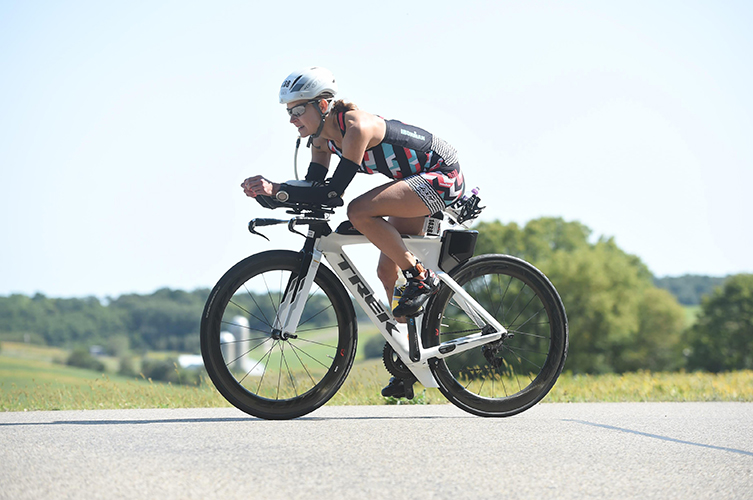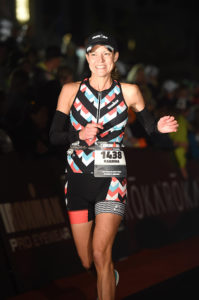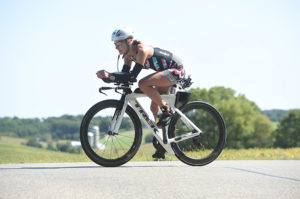
Snap, Crackle, Pop!
Kaarina Marsili’s inspirational come-back story
Q. Let’s set the stage. What happened at mile 16 – the mile your femur snapped during the 2016 Chicago Marathon?
A. I was cruising along until mile 13 — on pace to achieve my goal of a sub-5-hour marathon — when my left leg started to hurt. I thought it was my IT band. So, I slowed down and kept running until mile 16 when the pain got a lot worse. I stopped and decided to stretch it out, still thinking it was my IT band or piriformis. I balanced myself against a street sign and did a “figure-four” stretch, when all of sudden I heard a snap/crackle/pop. I knew immediately my leg was broken and lowered myself to the ground and yelled, “Call 911!” I was surrounded by spectators and other runners in seconds. I remember a middle-aged man in a baseball cap holding my hand; I must have squeezed the blood out his! And there was a young female runner who stayed with me; I begged her to keep going and not ruin her race time. I’d say the ambulance was there in five minutes, and I pretty much screamed bloody murder when the paramedic lifted me onto the gurney. I can’t even describe the pain to you.
 Q. What lead to the femur break, i.e., undiagnosed stress fracture?
Q. What lead to the femur break, i.e., undiagnosed stress fracture?
A. The doctors don’t know for sure, and my blood work and bone density scan came back normal. The theory is that I developed a stress fracture from too much training – I had just completed Ironman Coeur d’Alene two months earlier in August of 2016.
Q. And then… what happened next… surgery, rod in leg, physical therapy (PT)?
A. None of us, including the doctors, could believe that I had broken my femur, the largest bone in your body. I had surgery the next day to insert a titanium rod from my hip to my knee. Screws at the top and bottom hold it in place. I was released a few days later and started outpatient PT the same week. I couldn’t walk without crutches, and even the simple act of rolling over on the PT table seemed impossible. I would go on to do PT for about 10 months.
Q. What was the future looking like with your training and racing at first?
A. My doctor and therapist gave me milestones to shoot for, and those goals kept me going – e.g., I could start swimming once my incisions healed (about 8 weeks), I could start indoor biking once my bone started to grow around the rod (about 10 weeks), and I could start running once the bone was completely healed (about 5 months). However, the real challenge was overcoming the nerve damage and rebuilding the glute and leg muscles that had been damaged by the surgery. None of us knew for sure how that was going to go, and living with that uncertainty was hard at times. Today, I still struggle to stand up from a chair using just my left leg. My goal is to be able to do that by October 10!
Q. How did Precision MultiSport help in getting you stronger, taking into account your healing and any PT? What coach(es) did you work with/how did they help?
A. I started training with JP Bordeleau at Precision MultiSport in March of 2017, when I could start running again. I had never worked with a coach before, but I had gotten to know JP while doing CompuTrainer over the years and believed he’d be key to getting me race-ready again. Without a doubt, his structured workouts, advice and support were critical to helping me get stronger – and, importantly, avoid re-injury. Training with JP and doing CompuTrainer with Bill McCarthy on Wednesday mornings was also a lot of fun and a highlight of my week! Overall, I think I enjoyed and appreciated the journey to this Ironman more than I did for the two others I’ve done.
Q. Frustrations or any set-backs along the way? How did you push through?
A. It seemed that for every step forward, I would take one step back, and that was very frustrating. For example, just when one part of my leg was getting better a new part of it would start hurting, and my patience grew thin. I worked with JP and my physical therapist to adapt my regimen as needed, and it was their reassurance that I was heading in the right direction that inspired me to keep going. I also made sure to keep JP apprised of what I was doing in therapy, and my therapist apprised of my training.
Q. What was your first race post-surgery and how many months after surgery? Apprehension going into it? How did you feel during race and post-race?
A. My first post-surgery race was the Chicago Spring Half Marathon and 10k on May 21, 2017 (about 7 months after breaking my leg). I did the 10k in 59:26. I had no idea what my pace would be and promised myself just to have fun. It was a really emotional day, however. The course overlapped with parts of the Chicago Marathon, and the memories flooded back. As an homage, I wore the same plaid running pants that I wore when I broke my leg. They wanted to cut them off of me in the hospital, but I refused. They were my favorite and still are! It was a beautiful spring day in Chicago, and my husband Rich and I hung out for a long time after the race. I felt like he and I had our old lives (as racing partners) back again.
 Q. Ironman Wisconsin (IMWI) this September was your A race that you had your goals set to. What was the training like for the A race; what did you perhaps incorporate into your post-surgery workouts for your A race, i.e., more strength training, working in smaller distances with more frequency, etc.?
Q. Ironman Wisconsin (IMWI) this September was your A race that you had your goals set to. What was the training like for the A race; what did you perhaps incorporate into your post-surgery workouts for your A race, i.e., more strength training, working in smaller distances with more frequency, etc.?
A. I had signed up for IMWI before breaking my leg and paid the nonrefundable entry fee. Once I was running again, I figured I might as well give IMWI a shot, but it wasn’t really about the money. Knowing that IMWI was looming six months away gave me the purpose I needed to keep getting stronger. Since I had to build my running mileage slowly, JP put me through leg strength workouts at Precision. And because swimming would irritate my leg when I kicked, we focused on upper body strength training and swimming with a pull buoy. The bike came back the fastest, so that was the area we emphasized, making sure every ride had a clear purpose (intensity, course, tempo). My first post-surgery triathlon was the Lake Zurich Olympic distance on July 9, 2017 and was a good test for IMWI. I was thrilled to have a strong bike at Lake Zurich (20.1 mph average and 10th female overall) even though my swim and run were slower than the year before. I remember being so happy at the end of the race that I sprinted the finish even though it meant I had to ice my leg for a long time afterwards. The only other race I did in prep for IMWI was the Chicago Rock ‘n’ Roll Half Marathon on July 16. That mileage was tough on my leg. After that, JP had me focus on “time on my feet,” even if it meant taking walking breaks. My longest run prior to IMWI would end up being 16 miles.
Q. Worth every ounce of sweat and grit… you crossed that IMWI finish line – congratulations! Describe that for us.
A. IMWI arrived on September 10, 2017 — exactly 11 months to the day that I had my surgery. It was also my daughter’s 12th birthday. She had written me a series of notes to read before the race, including one that said, “Never give up, which is what I have learned from you.” She wasn’t able to come watch IMWI, but thinking about her kept me going, especially when I was cold and exhausted on the 2.4-mile swim and just wanted to grab a kayak and call it quits. Another highlight was seeing Rich as I was heading out on the 112-mile bike ride – he was spectating. It was kind of surreal thinking back to 2009 when I came to watch Rich race IMWI; it was my first time watching an Ironman, and I had yet to become a runner, biker or swimmer! Now, here I was racing IMWI, and he was supporting and believing in me – just as he had been from the day of my injury. I felt like we’d come full circle. Seeing Craig Strong of Precision Multisport at the top of the Midtown hill on the bike course was a great pick-me-up — as was seeing JP four times on the run. When you’re having self-doubt, seeing familiar faces who believe in you has a huge impact. Really appreciated having Craig and JP out there. I ended up getting a bit nauseous on the second loop of the bike and throughout the run, so that slowed me down a bit and probably helped me to save my leg! All I could eat at each run aid station was one tiny pretzel and a sip of Coke, so I was quite low on calories, but like lot of racers, I found the energy to run the last stretch around the capital building and across the finish line with about 45 minutes to spare!
Q. What is your best advice for those of us who may be facing a physical challenge and how to work through it.
A. I feel like my challenge pales in comparison to others I see out there. For example, I know a man from one of my training groups who weighed 500 pounds six years ago and now weighs about 225; IMWI was his first Ironman, and he completed it a few minutes after me. He and I ran/walked together for a few minutes during IMWI, and he talked about how amazing and resilient the human body is and that anything is possible if you put your mind to it. I think those words are so true. For me, the key was to focus on the small things you can do TODAY (from learning to roll over on the PT table to putting one foot in front of the other during IMWI) and eventually they will all add up to get you to your ultimate goal, whatever that may be.